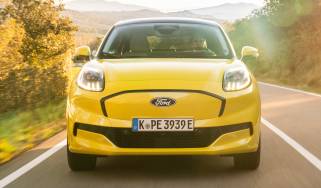Ford Fiesta hatchback - MPG, running costs & CO2 (2017-2023)
The latest Ford Fiesta is very economical, but limited electrification will reduce its appeal to some buyers
Low running costs have always been a key part of the Fiesta’s appeal, but Ford clearly hasn’t rested on its laurels for the latest model. CO2 emissions and fuel consumption are both competitive, while insurance and servicing are competitively priced. There’s no electric or proper hybrid model, though, so you’ll need to look at the Renault Clio, Honda Jazz, Toyota Yaris or Peugeot e-208 for more electrification.
Ford Fiesta MPG & CO2
While the Fiesta’s petrol engines are not quite as economical as the discontinued diesel engine, they are still very capable. We’d recommend going for Ford’s excellent 99bhp 1.0-litre EcoBoost engine, which returns up to 51.4mpg.
Impressively, the manual 123bhp mild-hybrid version is capable of up to 56.5mpg, but is slightly costlier to buy. CO2 emissions for this engine range from 114g/km to 122g/km, which is a little lower than the non-hybrid and will therefore be better for company car users. The same engine also comes with the only automatic gearbox offered on the Fiesta. This only slightly decreases fuel economy to 53.3mpg, and CO2 emissions increase to between 119g/km and 127g/km meaning it’ll come with a slightly higher BiK liability. If you do go for the automatic version, make sure it’s the latest seven-speed ‘DCT’ or ‘PowerShift’ branded gearbox as the discontinued six-speed auto could only manage 42.2mpg.
More reviews
In-depth reviews
- Ford Fiesta review (2017-2023)
- Ford Fiesta ST hatchback review
- Ford Fiesta Active hatchback review
- Ford Fiesta ST hatchback (2013-2017)
- Ford Fiesta hatchback (2008-2017)
Road tests
Used car reviews
Road tax for non-hybrid Fiesta models costs the standard VED amount annually. The mild-hybrid versions are taxed at the discounted VED rate.
Insurance
Insurance groups for the new Fiesta start from group seven (out of 50) for Trend models with the 1.1-litre petrol. The mild-hybrid engine occupies groups 17-18, while the 99bhp engine in any trim sits in group 14. The most expensive version to insure is the Fiesta ST, which sits in group 26, whichever version or options you choose. Consequently, insurance may be costlier than that of the Fiesta’s rivals - the Volkswagen Polo starts from a very low group three - so it’s possible the Fiesta’s lack of autonomous emergency braking has pushed its groupings up.
Servicing
Ford has the most expansive UK dealer network of any carmaker, so there’s rarely a branch far from home. This means routine servicing should be convenient – if not always the cheapest. Expect the latest Fiesta to require servicing annually, with conditions varying between models – your owner’s handbook will confirm which regime your car and engine belong to. Ford can offer a pre-paid servicing package to cover your first two or three services – ask your dealer to recommend a plan that suits your circumstances.
Warranty
The standard Ford UK warranty is three years or 60,000 miles – the same as provided with the Fiesta’s rivals from Volkswagen, Skoda and SEAT. It’s markedly less generous than the five-year/unlimited-mileage policy provided with the Hyundai i10, though, and nor can it match the seven-year/100,000-mile policy that covers the Kia Rio or the Toyota Yaris’ 10-year cover. Ford does offer you the opportunity to extend your Fiesta’s warranty to four or five years, at extra cost.















